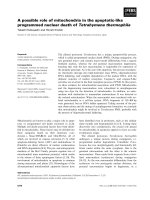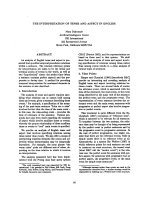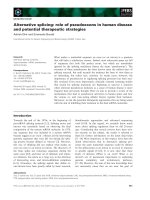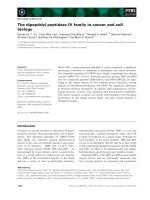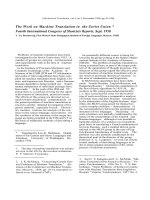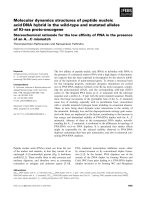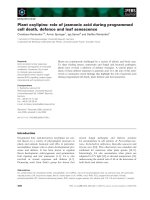Báo cáo khoa học: The catalytic role of the distal site asparagine-histidine couple in catalase-peroxidases potx
Bạn đang xem bản rút gọn của tài liệu. Xem và tải ngay bản đầy đủ của tài liệu tại đây (356.7 KB, 8 trang )
The catalytic role of the distal site asparagine-histidine couple
in catalase-peroxidases
Christa Jakopitsch
1
, Markus Auer
1
,Gu¨ nther Regelsberger
1
, Walter Jantschko
1
, Paul G. Furtmu¨ ller
1
,
Florian Ru¨ ker
2
and Christian Obinger
1
1
Institute of Chemistry and
2
Institute of Applied Microbiology, University of Agricultural Sciences, Vienna, Austria
Catalase-peroxidases (KatGs) are unique in exhibiting an
overwhelming catalase activity and a peroxidase activity of
broad specificity. Similar to other peroxidases the distal
histidine in KatGs forms a hydrogen bond with an adjacent
conserved asparagine. To investigate the catalytic role(s) of
this potential hydrogen bond in the bifunctional activity of
KatGs, Asn153 in Synechocystis KatG was replaced with
either Ala (Asn153fiAla) or Asp (Asn153fiAsp). Both
variants exhibit an overall peroxidase activity similar with
wild-type KatG. Cyanide binding is monophasic, however,
the second-order binding rates are reduced to 5.4%
(Asn153fiAla) and 9.5% (Asn153fiAsp) of the value of
native KatG [(4.8 ± 0.4) · 10
5
M
)1
Æs
)1
at pH 7 and 15 °C].
The turnover number of catalase activity of Asn153fiAla is
6% and that of Asn153fiAsp is 16.5% of wild-type activity.
Stopped-flow analysis of the reaction of the ferric forms with
H
2
O
2
suggest that exchange of Asn did not shift significantly
the ratio of rates of H
2
O
2
-mediated compound I formation
and reduction. Both rates seem to be reduced most probably
because (a) the lower basicity of His123 hampers its function
as acid-base catalyst and (b) Asn153 is part of an extended
KatG-typical H-bond network, the integrity of which seems
to be essential to provide optimal conditions for binding and
oxidation of the second H
2
O
2
molecule necessary in the
catalase reaction.
Keywords: catalase-peroxidase; Synechocystis PCC 6803;
catalase activity; peroxidase activity; compound I.
On the basis of sequence similarities with yeast cyto-
chrome c peroxidase (CCP) and plant ascorbate peroxidases
(APXs), catalase-peroxidases (KatGs) have been shown to
be members of class I of the superfamily of plant, fungal and
bacterial heme peroxidases [1]. KatGs have been found in
prokaryotes (archaebacteria and eubacteria) and fungi and
are homomultimeric proteins with monomers being twice as
large as CCP or APXs adding up to about 79–85 kDa,
whichisascribedtogeneduplication[2].FrombothCCP
and APX the crystal structures have been solved [3,4] and,
quite recently, the 2.0 A
˚
crystal structure of the homo-
dimeric KatG from Haloarcula marismortui has been
published [5]. This structure and sequence alignments
suggest that all class I peroxidases have conserved the
amino-acid triad His, Asp and Trp in the proximal pocket
and the triad Trp, Arg and His in the distal pocket (Fig. 1).
Despite this homology, class I peroxidases dramatically
differ in their reactivities towards hydrogen peroxide and
one-electron donors. Catalase-peroxidases have a predo-
minant catalase activity but differ from monofunctional
catalases in also exhibiting a substantial peroxidatic activity
with broad specificity. However, no substantial catalase
activity has ever been reported for either CCP or APX.
Cytochrome c peroxidase (CCP) is unusual in that it prefers
another protein (cytochrome c) as a redox partner, whereas
ascorbate peroxidases (APXs) prefer the anion ascorbate as
electron donor. But both cytochrome c and ascorbate are
poor substrates for KatGs [6–8].
The initial step in the catalytic mechanism of a peroxidase
and catalase is heterolysis of the oxygen-oxygen bond of
hydrogen peroxide. This reaction causes the release of one
water molecule and coordination of the second oxygen
atom to the iron center [9]. The resulting intermediate,
compound I, is two oxidizing equivalents above the resting
state; two electrons have been transferred from the enzyme
to the coordinated oxygen atom, one from the iron and one
from either the porphyrin or an amino-acid residue [9]. With
most peroxidases compound I is a ferryl (Fe
IV
¼O)
porphyrin p-cation radical, whereas for some intermediates
such as CCP compound I a ferryl (Fe
IV
¼O) protein radical
has been reported [10]. Recently, residues in the putative
distal active site of KatGs have been the targets of site-
directed mutagenesis studies. The role of distal Trp, Arg and
His was studied in the KatGs from Escherichia coli [11,12]
and from the cyanobacterium Synechocystis PCC 6803
[12,13]. The data presented in these papers suggest that
distal His and Arg in KatGs have a similar role in
compound I formation as in other peroxidases [9].
The main difference in the catalase and peroxidase
activity is compound I reduction. In the catalase cycle, a
Correspondence to C. Obinger, Institute of Chemistry,
Metalloprotein Research Group, University of Agricultural Sciences,
Muthgasse 18, A-1190 Vienna, Austria.
Fax: + 43 1 36006 6059, Tel.: + 43 1 36006 6073,
E-mail:
Abbreviations: KatG, catalase-peroxidase; APX, ascorbate
peroxidase; CCP, cytochrome c peroxidase; HRP, horseradish
peroxidase; CT1 (>600 nm), long wavelength porphyrin-
to-metal charge transfer band.
(Received 26 August 2002, revised 14 January 2003,
accepted 22 January 2003)
Eur. J. Biochem. 270, 1006–1013 (2003) Ó FEBS 2003 doi:10.1046/j.1432-1033.2003.03476.x
second peroxide molecule is used as a reducing agent for
compound I. This two-electron reduction completes the
cycle forming the ferric enzyme and molecular oxygen,
whereas in the peroxidase cycle, compound I is reduced in
two consecutive one-electron steps via compound II back to
the ferric enzyme. It has been demonstrated [11–13], that in
KatGs the distal Trp is essential for the H
2
O
2
-mediated two-
electron reduction step of compound I. The reasoning for
this was based on the observations that in the Trp variants
(a) the catalase activity was significantly reduced [11] or even
lost [12,13], whereas (b) the ratio of peroxidase to-catalase
activity was increased dramatically [11] indicating that
compound I formation was not influenced by this mutation.
Alignment of amino-acid sequences and inspection of the
crystal structures of members of the plant, fungal and
bacterial superfamily show the existence of a hydrogen bond
between the distal His and an Asn (Fig. 1) [3–5]. The
corresponding residues in class I peroxidases are Asn82
(CCP), Asn72 (pea APX) and Asn153 in Synechocystis
KatG (Fig. 1). Replacement of Asn82 of CCP [14,15] and
Asn70 in horseradish peroxidase (HRP) [16,17] has been
reported. Whereas with CCP the effect of disruption on the
catalytic activity was not studied, the HRP mutants
Asn70fiVal and Asn70fiAsp showed decreased rates in
compound I formation by hydrogen peroxide. Compounds
I and II reduction by phenolic substrates were slower
whereas reduction by ABTS [2,2¢-azino-bis-(3-ethylbenzo-
thiazoline-6-sulfonic acid)] was substantially increased.
As KatGs are the only peroxidases which are competent
to reduce and oxidize hydrogen peroxide at a reasonable
rate, it is important to understand the role of the H-bonding
partners of the conserved distal site residues Trp, Arg and
His. In this work Asn153 of KatG from Synechocystis PCC
6803 was replaced with Asp (Asn153fiAsp) and Ala
(Asn153fiAla). A comprehensive kinetic analysis of both
the catalase and the peroxidase activity including multimix-
ing stopped-flow spectroscopy is presented and discussed
with respect to the extraordinary catalytic features of
catalase-peroxidases.
Materials and methods
Reagents
Standard chemicals and biochemicals were obtained
from Sigma Chemical Co. at the highest grade available.
Fig. 1. Distal site structure of catalase-peroxi-
dase from Haloarcula marismortui. The figure
was constructed using the coordinates depo-
sitedintheProteinDataBank(accessioncode
1ITK). The amino-acid numbering is for
Haloarcula KatG, but numbers in parentheses
denote numbering for Synechocystis KatG.
Onlyoneselectedhydrogenbondisshown.
(B) Multiple sequence alignment performed
for all three branches of class I peroxidases.
The overall amino-acid sequence identity
between Synechocystis KatG and Haloarcula
KatG is 55%. Selected residues conserved in
all class I peroxidases are bold. Syn_PCC6803,
KatG from Synechocystis PCC 6803;
CATA_HALMA, KatG from Haloarcula
marismortui; CATA_MYCOTU, KatG from
Mycobacterium tuberculosis; HPI E_COLI,
KatG from Escherichia coli;CCP,yeastcyto-
chrome c peroxidase; APX, cytosolic pea
ascorbate peroxidase.
Ó FEBS 2003 The asparagine–histidine couple in catalase-peroxidases (Eur. J. Biochem. 270) 1007
Expression, purification of KatGs from Synechocystis and
spectrophotometric characterization of wild-type and
mutant proteins was described previously [13].
Mutagenesis
Oligonucleotide site-directed mutagenesis was performed
using PCR-mediated introduction of silent mutations as
described [13]. A pET-3a expression vector that contained
the cloned catalase-peroxidase gene from the cyanobacte-
rium Synechocystis PCC 6803 [7,13] was used as the template
for PCR. At first unique restriction sites were selected
flanking the region to be mutated. The flanking primers
were 5¢-AATGATCAGGTACCGGCCAGTAAATG-3¢
containing a KpnI restriction site and 5¢-TGCATAAAGG
ATCCGGGTGC-3¢ containing a BamHI restriction site.
The following mutant primers with the desired mutation
and a silent mutation introducing a restriction site were
constructed (point mutations italicized and restriction sites
underlined): 5¢-CTGAAT
TCCTGGCCAGATGCCGTC
AATTTAGAC-3¢ and 5¢-CCAGGAAT
TCAGGGGGG
CGAAGC-3¢ introduced the restriction site EcoRI and
changed Asn153 to Ala; 5¢-CCTGAAT
TCCTGGCCA
GAT
GACGTCAATTTAGAC-3¢ and 5¢-CCAGGAAT
TCAGGGGGGCGAAGC-3¢ introduced the restriction
site EcoRI and changed Asn153 to Asp.
Steady-state kinetics
Catalase activity was determined polarographically in
50 m
M
phosphate buffer using a Clark-type electrode
(YSI 5331 Oxygen Probe) inserted into a stirred water
bath (YSI 5301B) at 25 °C. One unit of catalase is defined
as the amount that decomposes 1 lmol of H
2
O
2
Æmin
)1
at
pH 7 and 25 °C. Peroxidase activity was monitored
spectrophotometrically using 1 m
M
H
2
O
2
and 5 m
M
guaiacol (e
470
¼ 26.6 m
M
)1
Æcm
)1
)or1m
M
o-dianisidine
(e
460
¼ 11.3 m
M
)1
Æcm
)1
). One unit of peroxidase is defined
as the amount that decomposes 1 lmol of electron
donor min
)1
at pH 7 and 25 °C.
Transient-state kinetics
Transient-state measurements were made using the model
SX-18
M
V stopped-flow spectrophotometer from Applied
Photophysics equipped with a 1-cm observation cell ther-
mostated at 15 °C. This temperature was chosen to allow
comparison with transient kinetic data of other KatG
variants investigated under identical conditions. Calculation
of pseudo-first-order rate constants (k
obs
) from experimental
traces at the Soret maximum was performed with the
SpectraKinetic workstation v4.38 interfaced to the instru-
ment. The substrate concentrations were at least five times
that of the enzyme to allow determination of pseudo-first-
order rate constants. Second-order rate constants were
calculated from the slope of the linear plot of pseudo-
first-order rate constants vs. substrate concentration. To
follow spectral transitions a photodiode array accessory
(model PD.1 from Applied Photophysics) connected to the
stopped-flow machine together with the
XSCAN DIODE
ARRAY SCANNING
v1.07 software was utilized. The kinetics
of oxidation of ferric catalase-peroxidase to compound I by
peroxides (peroxoacetic acid or m-chloroperbenzoic acid) or
the formation of the cyanide complex had to be followed in
the single mixing mode. Catalase-peroxidase and the
peroxide or cyanide were mixed to give a final concentration
of 1 l
M
enzyme and 20–500 l
M
peroxide or 20–500 l
M
cyanide. The first data point was recorded 1.5 ms after
mixing and 2000 data points were accumulated. Sequential-
mixing stopped-flow analysis was used to measure com-
pound I reduction by one-electron donors. In the first step
the enzyme was mixed with peroxoacetic acid and, after a
delay time where compound I was built, the intermediate
was mixed with the electron donors aniline, ascorbate or
o-dianisidine. All stopped-flow determinations were meas-
ured in 50 m
M
phosphate buffer, pH 7.0 and 15 °C, and at
least three determinations were performed per substrate
concentration.
Results
Spectral properties
Figure 2 depicts the UV-Vis spectra of wild-type KatG and
the two variants investigated in this study. The absorption
spectrum of the Asn153fiAla variant resembles closely that
of the recombinant wild-type enzyme in the resting state
[7,12,13] exhibiting the typical bands of a heme b-containing
ferric peroxidase in the visible and near ultraviolet region.
The Soret peak at 406 nm (small shoulder at 380 nm)
together with two bands around 512 and 640 nm (CT1)
suggest the presence of a dominating five-coordinate
high-spin heme coexisting with some six-coordinate high-
spin heme. The A
406
/A
280
ratio (i.e. Reinheitszahl) of
Asn153fiAla varies between 0.46 and 0.48 from one
preparation to another (wild-type protein: 0.57–0.61). The
Reinheitszahl of Asn153fiAsp is in the range 0.42–0.45 and
the peaks in the UV/Vis spectrum are at 408, 512 and
640 nm. The small shoulder at 368 nm indicates the
presence of some free heme corresponding with the slightly
Fig. 2. UV-Vis spectra of the ferric forms of Synechocystis wild-type
KatG and of the variants Asn153fiAla and Asn153fiAsp. Conditions:
Ferric proteins in 50 m
M
phosphate buffer, pH 7.0, and 25 °C. The
absorbance ratio (A
Soret
/A
280
) of the proteins was 0.60 for wild-type
KatG, 0.47 for Asn153fiAla, 0.44 for Asn153fiAsp, respectively. The
region between 460 and 700 nm has been expanded sixfold.
1008 C. Jakopitsch et al. (Eur. J. Biochem. 270) Ó FEBS 2003
lower Reinheitszahl of Asn153fiAsp. These spectral data
together with the kinetic parameters presented below
suggest that the mutations caused no significant changes
in the interactions of the heme with the apoprotein.
The protein yield was similar for all recombinant proteins
(60–80 mg recombinant KatG from 1 L of E.coliculture).
Catalase and peroxidase activity
Recombinant KatG exhibits an overwhelming catalase
activity. The polarographically measured specific catalase
activity in the presence of 5 m
M
hydrogen peroxide is
1160 ± 55 UÆmg
)1
of protein. With 100 l
M
H
2
O
2
and
20 m
M
pyrogallol or 1 m
M
H
2
O
2
and 5 m
M
guaiacol, the
peroxidase activity was determined to be 6.6 ± 0.6 or
0.6 ± 0.1 UÆmg
)1
, respectively. Table 1 shows, what hap-
pens upon exchanging Asn153. Both variants exhibit a
reduced catalase activity. Compared with wild-type KatG
the k
cat
values of Asn153fiAla and Asn153fiAsp were
determined to be 6% and 17%. Figure 3 shows the pH
dependence of the catalase activity. The KatG-specific pH
dependence with a maximum activity at pH 6.5 is seen with
both Asn153fiAsp and Asn153fiAla (not shown) indica-
ting that the distal His in KatGs should not be one of the
key residues responsible for this typical pH profile. The
affect of mutation on the overall peroxidase activity can be
neglected. Both mutants exhibited similar oxidation rates
of guaiacol and o-dianisidine as the wild-type protein
(Table 1).
Cyanide binding
Cyanide is a useful probe to investigate the binding site of
heme proteins. Figure 4A shows the spectral changes upon
addition of cyanide to ferric wild-type KatG and
Asn153fiAla. A similar low spin spectrum is obtained
when Asn153fiAsp is mixed with excess cyanide (not
shown). The Soret peak of wild-type KatG shifts to 422 nm
accompanied by a small hypochromicity (isosbestic point
at 414 nm) and a prominent new peak at 542 nm is seen.
The corresponding peaks of the cyanide complex of
Table 1. Apparent K
m
and k
cat
values for the catalase activity of wild-type and variant catalase-peroxidases from Syne chocystis PCC 6803. Also given
are specific peroxidase activities (units per mg protein). Reaction conditions: 50 mM phosphate buffer, pH 7, and 30 °C. For catalase and
peroxidase assays as well as unit definition see Materials and methods.
Wild-type Asn153fiAla Asn153fiAsp
Catalase activity
K
m
(m
M
H
2
O
2
) 4.1 ± 0.2 1.7 ± 0.2 2.3 ± 0.3
k
cat
(s
)1
) 3500 ± 350 200 ± 25 580 ± 34
k
cat
/K
m
(· 10
5
M
)1
Æs
)1
) 8.5 1.2 2.5
Peroxidase activity
o-Dianisidine (lmolÆmin
)1
Æmg
)1
) 3.8 ± 0.6 1.9 ± 0.6 4.3 ± 0.5
Guaiacol (lmolÆmin
)1
Æmg
)1
) 0.6 ± 0.1 0.55 ± 0.09 0.6 ± 0.4
Fig. 3. pH profile for catalase activity of Synechocystis catalase-
peroxidase. The specific catalase activity of wild-type KatG and the
variant Asn153fiAsp (N153D) is given in lmol O
2
formed per minute
and mg protein as determined polarographically at 25 °Cin50m
M
citrate-phosphate or Tris buffers, pH 4.0–9.0.
Fig. 4. Cyanide binding to the ferric forms of Synechocystis wild-type
KatG and Asn153fiAla. (A) UV-Vis spectra of the ferric forms
and cyanide complexes of Synechocystis wild-type KatG and
Asn153fiAla. Conditions: ferric proteins (2 l
M
) were mixed with
10 m
M
cyanide in 100 m
M
phosphate buffer, pH 7.0, and 25 °C. The
region between 460 and 700 nm has been expanded sixfold. (B) Typical
time trace and fit of the reaction between Asn153fiAla (1 l
M
)and
100 l
M
cyanide followed at 427 nm in 50 m
M
phosphate buffer,
pH 7.0, and 15 °C. (C) Pseudo-first-order rate constants for the for-
mation of the cyanide complex of Asn153fiAla in 50 m
M
phosphate
buffer, pH 7.0, and 15 °C.
Ó FEBS 2003 The asparagine–histidine couple in catalase-peroxidases (Eur. J. Biochem. 270) 1009
Asn153fiAla are at 420 nm (isosbestic point at 413 nm)
and 544 nm, respectively (Fig. 4A). Cyanide binding was
monophasic and gave single exponential curves, indicating
pseudo-first-order kinetics. A typical time trace followed at
427 nm (the maximum absorbance difference between the
cyanide complex and the ferric protein) and the corres-
ponding fit are shown in Fig. 4B. The observed rate of
cyanide binding to the ferric enzyme linearly increased with
the concentration of cyanide. The slope yielded the apparent
second-order rate constant for cyanide binding (k
on
). The
value obtained for the wild-type enzyme is (4.8 ± 0.4) ·
10
5
M
)1
Æs
)1
at pH 7 and 15 °C. The finite intercept (7.6 s
)1
)
represents k
off
.Fromtheratiok
off
/k
on
a value for the
dissociation constant of the cyanide complex to ferric
enzyme and cyanide of 15.8 l
M
was calculated. The present
data unequivocally demonstrate that Asn153 plays a role in
cyanide binding. In both variants cyanide binding was
monophasic (see single exponential fit in Fig. 4B; normal-
ized variance ¼ 3.95 · 10
)7
), but the binding rate was
drastically reduced (Fig. 4C). With Asn153fiAla a binding
rate of (1.5 ± 0.4) · 10
4
M
)1
Æs
)1
and a dissociation con-
stant of 74.6 l
M
was calculated. With Asn153fiAsp similar
values were determined [k
on
¼ (4.6 ± 0.5) · 10
4
M
)1
Æs
)1
and k
off
/k
on
¼ 80.4 l
M
].
Compound I formation
As has been reported recently, the catalase activity of wild-
type KatGs does not allow to follow compound I formation
by addition of hydrogen peroxide [7,12,13]. However, upon
addition of peroxoacetic acid a compound I spectrum can
be obtained that is distinguished from the resting state by a
40–50% hypochromicity and its formation can be followed
as exponential absorbance decrease at the Soret maximum.
This is shown for wild-type Synechocystis KatG in Fig. 5B.
In case of Asn153fiAla and Asn153fiAspwithanexcessof
peroxoacetic acid these stopped-flow experiments also give
single exponential curves (Fig. 5C) and the plots of the
pseudo-first-order rate constants, k
obs
, vs. peroxoacetic acid
concentration are linear with very small intercepts (Fig. 5D).
From the slope the bimolecular rate constants were
calculated to be (2.6 ± 0.3) · 10
4
M
)1
Æs
)1
(Asn153fiAla)
and (4.2 ± 0.4) · 10
4
M
)1
Æs
)1
(Asn153fiAsp) at pH 7 and
15 °C. As Table 2 demonstrates these rates are similar to
wild-type KatG. By contrast, compound I formation
mediated by m-chloroperbenzoic acid is faster in both
Asn153fiAla and Asn153fiAsp compared with wild-type
KatG (Table 2). However, neither with peroxoacetic acid
(Fig. 5A) nor with m-chloroperbenzoic acid a hypochro-
micity of 40–50% could be obtained as is the case with the
wild-type protein. The maximum observed hypochromicity
was 19%. Nevertheless, the formed redox intermediate was
stable for seconds and allowed to study its reactivity with
electron donors using the sequential-mixing stopped-flow
technique.
Compound I reduction
In a typical experiment, 4 l
M
recombinant protein was
premixed in the aging loop with 400 l
M
peroxoacetic acid
and, after a delay time of 3 s, the electron donor was added.
Similar to earlier observations with wild-type KatG and
distal mutants [7,12,13], addition of classical one-electron
donors to compound I resulted in the formation of an redox
intermediate with spectral features that did not resemble a
typical (red-shifted) compound II spectrum known from
other peroxidases (e.g. horseradish peroxidase or APX) but
was similar to the ferric protein. The Soret band remains at
406 nm, however, the extinction coefficient is between that
of compound I and the ferric protein. Consequently,
compound I reduction of both Asn153fiAla and
Asn153fiAsp has been followed at 406 nm. A typical time
Fig. 5. Compound I formation and reduction of wild-type Synechocystis
KatG and Asn153fiAla. (A) Spectral changes upon addition of per-
oxoacetic acid to ferric Asn153fiAla. Final concentrations: 100 l
M
peroxoacetic acid and 1 l
M
Asn153fiAla.Firstspectrumisthatof
ferric enzyme. Second spectrum (bold) is that of compound I and was
taken after 1 s. The inset shows the corresponding time trace at
406 nm and 15 °C(50m
M
phosphate buffer, pH 7.0). (B) Spectral
changes upon addition of peroxoacetic acid to ferric wild-type KatG.
Final concentrations: 100 l
M
peroxoacetic acid and 10 l
M
wild-type
protein. First spectrum is that of ferric enzyme. Second spectrum
(bold) is that of compound I and was taken after 2 s. The inset shows
the corresponding time trace at 406 nm and 15 °C(50m
M
phosphate
buffer, pH 7.0). (C) Original time trace (406 nm) and single expo-
nential fit of the reaction between 1 l
M
ferric Asn153fiAla and
100 l
M
peroxoacetic acid at 15 °C and pH 7.0. (D) Pseudo-first-order
rate constants for the formation of Asn153fiAla compound I plotted
against peroxoacetic acid concentration. (E) Original time trace
(406 nm) of the reaction between 1 l
M
ferric Asn153fiAla compound
Iand2 m
M
ascorbate at 15 °C(50 m
M
phosphate buffer, pH 7.0). The
inset shows the exponential phase and fit used to calculate the k
obs
values. (F) Pseudo-first-order rate constants for the Asn153fiAla
compound I reduction plotted against ascorbic acid concentration.
1010 C. Jakopitsch et al. (Eur. J. Biochem. 270) Ó FEBS 2003
trace with ascorbate as electron donor is shown in Fig. 5E.
Inspection of the time trace shows that the reaction is
biphasic exhibiting an exponential increase (which could be
attributed to compound II formation) followed by a slow
conversion back to the ferric enzyme. The slow phase fits
well with the observation that ascorbate is generally a very
poor substrate of KatGs. In order to obtain actual
bimolecular rate constants which could represent the one-
electron reduction of compound I to compound II the first
exponential phase was fitted (see inset to Fig. 5E) and the
pseudo-first-order rate constants plotted against the electron
donor concentration (Fig. 5F). The finite ordinate intercept
in Fig. 5F could represent the rate of compound I reduction
in the absence of exogenous substrates. As Table 2 shows
unequivocally, mutation of Asn153 in Synechocystis KatG
had only minor effects on compound I reduction. Both the
order of magnitude as well as the hierarchy of donors
(ascorbate < aniline << o-dianisidine) is very similar in
wild-type KatG and both variants.
Discussion
The most prominent difference between peroxidases and
other heme proteins is the high reactivity towards
hydrogen peroxide. One of the essential features of this
reactivity is acid-base catalysis by a conserved distal
histidine which is located in the distal cavity and facilitates
the deprotonation of H
2
O
2
forming an initial Fe-OOH
complex and finally assists in the heterolytic cleavage of
the O–O bond by protonating the distal oxygen [18]. A
similar role plays the distal His in KatGs as has been
demonstrated recently by site-directed mutagenesis [11,13].
It plays a significant role in the distal H-bonding of
KatGs which also involves water molecules and the
conserved distal Trp and Arg [19]. In addition, as
suggested by the published structure of KatG from
Haloarcula marismortui and sequence alignments (Fig. 1),
the distal His123 of Synechocystis KatG is hydrogen-
bonded via its N
d
H to Asn153, an amino acid a bit far
from the immediate vicinity of the heme (Fig. 1).
Indeed, the kinetic parameters determined in this work
confirm the proposal that Asn153 is part of the distal
H-bond network in KatGs and is an important structural
determinant in the multifunctional activity of KatGs [13,19].
Firstly, disruption of the hydrogen bond between Asn153
and His123 reduces the overall catalase activity by about
one order of magnitude, whereas the influence on the overall
peroxidase activity is apparently neglectable. Secondly, in
the variants Asn153fiAla and Asn153fiAsp the binding
constants for cyanide to the ferric protein is about an order
of magnitude lower than the corresponding binding
constant of wild-type KatG. As the basicity of the distal
histidine is important in both hydrogen peroxide reduction
(i.e. compound I formation) and cyanide binding, it is
reasonable to assume that the disruption of the H-bond
makes the distal His less basic. As a consequence the pK
a
value of the N
e
H of the distal His is lowered and the rate
constant for the reaction with hydrogen peroxide and
cyanide is reduced. The line of reasoning that the H
2
O
2
-
mediated compound I formation is slower in the Asn153
variants can only be indirect because of the intrinsic high
catalase activity. Only when amino-acid exchanges diminish
the rate of compound I reduction by H
2
O
2
(i.e. exchange of
distal Trp [12] or proximal Trp [23]), the oxidation of ferric
KatG by hydrogen peroxide can be followed. In this respect
both Asn153fiAla and Asn153fiAspbehavesuchaswild-
type KatG and do not allow to follow this reaction.
However, similar data obtained with both CCP and HRP
underline the proposed role of Asn153 in KatG catalysis.
NMR spectroscopy clearly showed that in the CCP variant
Asn82fiAsp the hydrogen bond between the N
e
of His52
and heme-coordinated cyanide has been eliminated [14]. As
a consequence of mutation this CCP variant was shown to
exist in at least three forms and their dynamic interconver-
sion being controlled by pH, temperature and isotopic
effects [20]. Binding constants of fluoride and cyanide were
decreased in this CCP variant [15]. Unfortunately, no
kinetic data about H
2
O
2
-mediated compound I formation
of this variant are available and also no kinetic parameters
regarding the peroxidase activity in CCP Asn82fiAsp or a
corresponding APX variant. Nevertheless, investigations of
the class III model enzyme HRP and the Asn70fiVal and
Asn70fiAsp variants [16,17] unequivocally demonstrated
that the rates of compound I formation were reduced to
about 10% of the value of native HRP. All these findings
suggest a similar role of the distal Asn-His couple in plant-
type peroxidases.
The present work also clearly showed that the basicity of
the distal His has no impact on the reduction of organic
peroxides. With peroxoacetic acid the same rates were
obtained in wild-type and both mutant proteins, and with
m-chloroperbenzoic acid even higher rates were obtained in
the Asn153 variants. Generally, only little differences
between Asn153fiAla and Asn153fiAsp were observed
Table 2. Bimolecular rate constants of compound I formation and reduction of wild-type Synechocystis KatG and the variants Asn153fiAla and
Asn153fiAsp (50 mM phosphate buffer, pH 7, and 15 °C). Compound I was formed with peroxoacetic acid and its reactivity was tested by using the
sequential-mixing stopped-flow method (for details see Materials and methods).
Wild-type Asn153fiAla Asn153fiAsp
Compound I formation (· 10
3
M
)1
Æs
)1
)
Peroxoacetic acid 39 ± 4 26 ± 3 42 ± 4
m-Chloroperbenzoic acid 53 ± 8 157 ± 14 180 ± 19
Compound I reduction (· 10
3
M
)1
Æs
)1
)
Aniline 14 ± 6 68 ± 6 18 ± 5
o-Dianisidine 2710 ± 350 3400 ± 840 3670 ± 950
Ascorbate 5.4 ± 1.9 4.0 ± 0.9 5.1 ± 0.6
Ó FEBS 2003 The asparagine–histidine couple in catalase-peroxidases (Eur. J. Biochem. 270) 1011
with regard to their spectroscopic properties and reactivities,
though principally Asp is a potent hydrogen bond acceptor.
The crystal structure of CCP [3] indicates that Asn82
donates another hydrogen bond to the peptide carbonyl
oxygen atom of Glu76. This hydrogen bond also exists in
pea APX (Glu65) [4] and, based on the Haloarcula KatG
structure and sequence alignments, exists in Synechocystis
KatG (Leu147) and helps to additionally anchor the distal
His in the optimum position. It is reasonable to assume that
in Asn153fiAsp the Asp residue is deprotonated at the
polar distal site and therefore cannot act as a hydrogen
donor to the peptide group of Leu147. As a consequence
Asp cannot compensate the role of Asn and the distal His is
destabilized to the same extent in both Asn153fiAla and
Asn153fiAsp. A more open cavity could result and explain
the higher reactivity towards the more bulky organic
peroxides such as m-chloroperbenzoic acid.
At the moment we cannot explain why the organic
peroxides induce a hypochromicity of the Soret Band of at
most 20% compared to 40–50% in compound I formation
of wild-type KatG. We exclude that only a fraction of the
protein in its ferric form has been oxidized or that the
mutations induced a marked compound I instability
(meaning that we have observed a steady-state spectrum
and not that of pure Asn153fiAla or Asn153fiAsp
compound I). This reasoning is based on (a) inspection of
the spectra of the ferric forms, (b) the stopped-flow
observations that demonstrated that Asn153fiAla or
Asn153fiAsp compound I were stable for seconds, (c) that
theformedintermediateexhibitedthesamereactivity
towards one-electron donors as the wild-type intermediate,
and finally (d) that with cyanide a nearly 100% monophasic
transition to the low spin complex could be observed. More
likely are differences in the heme environment in wild-type
and mutant compound I caused by the poor anchoring of
distal His in both Asn153fiAla and Asn153fiAsp. As a
consequence the spectroscopic features of compound I
could be changed.
So the question remains how the disruption of the
hydrogen bond between His123 and Asn153 affects com-
pound I reactivity. No effect of mutation was observed
when one-electron donors were added to compound I. This
is in contrast to the HRP mutants Asn70fiVal [21] and
Asn70Asp [16] where compound I reduction rates by
phenolic substrates were reduced to less than 10% com-
pared to wild-type HRP. This is thought to be based on the
decreased basicity of the distal His that depresses the proton
abstraction from the donor (which precedes electron
transfer from the substrate to the heme in HRP [22]). Thus,
from the data of this work one may conclude that the distal
His in KatGs is not essential in the deprotonation step
during compound I reduction by phenolic donors.
However, replacement of Asn153 seems to reduce the rate
of hydrogen peroxide oxidation by compound I (i.e. the
catalase reactivity). This is deduced from the fact that the
overall catalase but not peroxidase activity is reduced upon
manipulation of Asn153. As changes in the rate of
compound I formation should have the same impact on
both catalase and peroxidase activity, it is reasonable to
assume that in both Asn153fiAla and Asn153fiAsp also
the H
2
O
2
-mediated reduction of compound I is diminished.
This fits well with recent observations that in most variants
the consequence of amino-acid exchange in the heme cavity
is a reduced catalase activity [12,13,19,23]. Recent spectro-
scopic investigations on Synechocystis KatG variants
(exchanges of Arg119, Trp122 and His123 [19]) showed
the existence of a pronounced H-bonding pattern at the
distal heme side involving also His123. The present work
unequivocally suggest that Asn153 is part of this network. It
is reasonable to assume that disruption of the hydrogen
bond between Asn153 and His123 has a strong influence on
this H-bonding network. Its disturbance impairs the con-
ditions for binding and oxidation of the second H
2
O
2
molecule necessary in the catalase reaction of this unique
peroxidase.
This proposed role of Asn153 is completely different from
that of its neighbour Asp152. Figure 1B shows that in
KatGs the distal Asn is part of the triad Pro-Asp-Asn (in
Synechocystis KatG Pro151-Asp152-Asn153). Asn is found
in all plant-type peroxidases, whereas Asp is conserved only
in KatGs. In CCP a serine substitutes the aspartate forming
the triad Pro80-Ser81-Asn82 and in APX an alanine
substitutes the aspartate giving the triad Gly69-Ala70-
Asn71, respectively (Fig. 1B). Preliminary investigations
about the role of this conserved distal aspartate showed,
that in Asp152 variants H
2
O
2
oxidation was much slower
than H
2
O
2
reduction (manuscript in preparation), which is
in contrast to wild-type KatG and the Asn153 variants
described in this paper. Asp152 seems to participate directly
in the H
2
O
2
oxidation reaction (i.e. the catalase activity)
whereas Asn153 participates indirectly in both the H
2
O
2
reduction (by enabling the distal histidine to function as
acid-base catalyst) and H
2
O
2
oxidation (by stabilizing the
KatG-typical H-bond network which is essential in the
catalase activity).
Acknowledgements
This work was supported by the Austrian Science Funds (FWF project
P15417).
References
1. Welinder, K.G. (1992) Superfamily of plant, fungal and bacterial
peroxidases. Curr. Opin. Struct. Biol. 2, 388–393.
2. Welinder, K.G. (1992) Bacterial catalase-peroxidases are gene
duplicated members of the plant peroxidase superfamily. Biochim.
Biophys. Acta 1080, 215–220.
3. Finzel, B.C., Poulos, T.L. & Kraut, J. (1984) Crystal structure of
yeast cytochrome c peroxidase refined at 1.7-A
˚
resolution. J. Biol.
Chem. 259, 13027–13036.
4. Patterson, W.R. & Poulos, T.L. (1995) Crystal structure of
recombinant pea cytosolic ascorbate peroxidase. Biochemistry 34,
4331–4341.
5. Yamada,Y.,Fujiwara,T.,Sato,T.,Igarashi,N.&Tanaka,N.
(2002) The 2.0 A
˚
crystal structure of catalase-peroxidase from
Haloarcula marismortui. Nat. Struct. Biol. 9, 691–695.
6. Obinger, C., Regelsberger, G., Strasser, G., Burner, U. &
Peschek, G.A. (1997) Purification and characterization of a
homodimeric catalase-peroxidase from the cyanobacterium
Anacystis nidulans. Biochem. Biophys. Res. Commun. 235, 545–
552.
7. Jakopitsch, C., Ru
¨
ker, F., Regelsberger, G., Dockal, M.,
Peschek, G.A. & Obinger, C. (1999) Catalase-peroxidase from the
cyanobacterium Synechocystis PCC 6803: cloning, overexpression
1012 C. Jakopitsch et al. (Eur. J. Biochem. 270) Ó FEBS 2003
in Escherichia coli, and kinetic characterization. Biol. Chem. 380,
1087–1096.
8. Engleder, M., Regelsberger, G., Jakopitsch, C., Furtmu
¨
ller, P.G.,
Ru
¨
ker,F.,Peschek,G.A.&Obinger,C.(2000)Nucleotide
sequence analysis, overexpression in Escherichia coli and kinetic
characterization of Anacystis nidulans catalase-peroxidase.
Biochimie 82, 211–219.
9. Dunford, H.B. (1999) Heme Peroxidases.Wiley-VCH,NewYork.
10. Sivaraja, M., Goodin, D.B., Smith, M. & Hoffman, B.M.
(1989) Identification by ENDOR of Trp191 as the free-radical
site in cytochrome c peroxidase compound ES. Science 245,
738–740.
11. Hillar, A., Peters, B., Pauls, R., Loboda, A., Zhang, H.,
Mauk, A.G. & Loewen, P.C. (2000) Modulation of the activities
of catalase-peroxidase HPI of Escherichia coli by site-directed
mutagenesis. Biochemistry 39, 5868–5875.
12. Regelsberger, G., Jakopitsch, C., Furtmu
¨
ller, P.G., Ru
¨
ker, F.,
Switala, J., Loewen, P.C. & Obinger, C. (2001) The role of distal
tryptophan in the bifunctional activity of catalase-peroxidases.
Biochem. Soc. Trans. 29, 99–105.
13. Regelsberger, G., Jakopitsch, C., Ru
¨
ker, F., Krois, D.,
Peschek, G.A. & Obinger, C. (2000) Effect of distal cavity muta-
tions on the formation of compound I in catalase-peroxidases.
J. Biol. Chem. 275, 22854–22861.
14. Satterlee, J.D., Alam, S.L., Mauro, J.M., Erman, J.E. &
Poulos, T.L. (1994) The effect of the Asn82fiAsp mutation in
yeast cytochrome c peroxidase studied by proton NMR spectro-
scopy. Eur.J.Biochem.224, 81–87.
15. Delauder, S.F., Mauro, J.M., Poulos, T.L., Williams, J.C. &
Schwarz, F.P. (1994) Thermodynamics of hydrogen cyanide and
hydrogen fluoride binding to cytochrome c peroxidase and its
Asn-82fiAsp mutant. Biochem. J. 302, 437–442.
16. Nagano, S., Tanaka, M., Ishimori, K., Watanabe, Y. &
Morishima, I. (1996) Catalytic roles of the distal site asparagine-
histidine couple in peroxidases. Biochemistry 35, 14251–14258.
17. Tanaka, M., Nagano, S., Ishimori, K. & Morishima, I. (1997)
Hydrogen bond network in the distal site of peroxidases: spec-
troscopic properties of Asn70fiAsphorseradish peroxidase
mutant. Biochemistry 36, 9791–9798.
18. Poulos, T.L. & Kraut, J. (1980) The stereochemistry of peroxidase
catalysis. J. Biol. Chem. 255, 8199–8205.
19. Heering, H.A., Indiani, C., Regelsberger, G., Jakopitsch, C.,
Obinger, C. & Smulevich, G. (2002) New insights into the heme
cavity structure of catalase-peroxidase: a spectroscopic approach
to the recombinant Synechocystis enzyme and selected distal cavity
mutants. Biochemistry 41, 9237–9247.
20. Satterlee, J.D., Teske, J.G., Erman, J.E., Mauro, J.M. & Poulos,
T.L. (2000) Temperature, pH, and solvent isotope effects on
cytochrome c peroxidase mutant N82A studied by proton NMR.
J. Protein Chem. 19, 535–542.
21. Nagano, S., Tanaka, M., Watanabe, Y. & Morishima, I. (1995)
Putative hydrogen bond network in the heme distal site of
horseradish peroxidase. Biochem. Biophys. Res. Commun. 207,
417–423.
22. Dunford, H.B. (1982) Horseradish peroxidase: structure and
kinetic properties. In Peroxidases in Chemistry and Biology,Vol.II
(Everse,J.,Everse,K.E.&Grisham,M.B.,eds),pp.1–24.CRC
Press, Boca Raton, Florida.
23. Jakopitsch, C., Regelsberger, G., Furtmu
¨
ller, P.G., Ru
¨
ker, F.,
Peschek, G.A. & Obinger, C. (2002) Engineering the proximal
heme cavity of catalase-peroxidase. J. Inorg. Biochem. 91, 78–86.
Ó FEBS 2003 The asparagine–histidine couple in catalase-peroxidases (Eur. J. Biochem. 270) 1013


